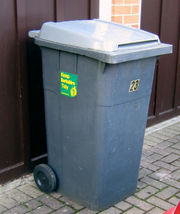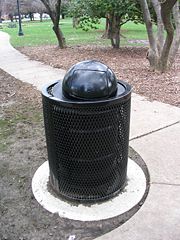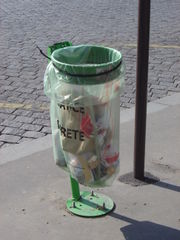Waste container
2008/9 Schools Wikipedia Selection. Related subjects: Environment
A waste container is a container for temporarily storing waste, which is usually made out of metal or plastic. Common terms are dustbin, rubbish bin, litter bin, garbage can, trash can, trash bin, dumpster, trash barrel, and rubbish barrel; the word can generally refers to a container made out of metal. The words "rubbish" and "bin" are more common in British English usage; "trash" and "can" are more common in American English usage.
Explanation
Indoor bins
Indoor bins are traditionally kept in the kitchen to dispose of culinary excess such as fruit peelings or bottles, although there are also wastepaper baskets or wastebaskets which are used in offices to dispose of waste paper and other office refuse. Sometimes a bin can simply be referred to as "the garbage" or "the trash", in an example of a question, such as when one might ask "Where's the bin?" in an unfamiliar kitchen.

Most bins have heavy lids on the top to seal in the odour that garbage tends to emit. Though most have to be opened manually, indoor bins sometimes have pedals which open the lid when stomped on. Many bins are now water tight and need to be checked to stop leaking.
Indoor bins are traditionally lined with bin bags, which keeps the bin itself clean, facilitates the removal of the garbage and allows disposal with minimal contact to the contents. A common practice is to place multiple bags in each bin once a day so that one can empty the container by removing the bag and not have to replace it, speeding up the process.
Rubbish is usually kept in these receptacles until full, at which point they are transferred via the aforementioned bin bags to an outside receptacle such as a dumpster, or simply to the roadside.
Curbside dustbins

The curbside dustbins usually consist of three types: trash cans (receptacles often made of tin, steel or plastic), Dumpsters (large receptacles similar to skips) and wheelie bins (light, usually plastic bins that are mobile). All of these are emptied by collectors, who will load the contents into a garbage truck and drive it to a landfill, incinerator or waste sorting facility to be disposed of.
In some areas there is also a recycling service, often with one or more dedicated bins intended to receive items that can be recycled into new products. These bins are separated into different categories (usually represented by colours) which determine what materials can be inserted into the bin. The most common materials used for recycling are paper, glass, metal, plastics and "green waste" (compostable material, either garden waste or food scraps or both).
The contents of the bins are taken to a recycling plant to be processed, and there are various systems for recycling bin collection: single bin combined stream systems, multiple bin systems, and cyclic collections with different materials collected on different days. Due to the over flow of trash, the world today is slowly being consumed by the waste of humans. In about 2300, the world will be over filled by trash.
Bins in public areas
Certain public areas such as parks have litter bins which are placed alongside paths frequently walked by visitors. This encourages people to avoid littering, which creates an unhealthy and aesthetically unpleasant social environment.
Bins in outdoor locations or other busy public areas are usually mounted to the ground or wall. This discourages theft, and also reduces vandalism by making it harder for someone to physically move or maneuver the bins; to spill their contents on the ground for example, or to use the bin as an effective weapon to hit people over the back with.
In the past terrorists have left improvised explosive devices in bins. The bomb is much less likely to be spotted than an unattended bag and the metal bins provide extra shrapnel that injures people nearby when it detonates. For this reason there are no bins in most railway stations, most airports, and many shopping centres in the United Kingdom, or if they are provided they are just a bin bag hanging from a metal loop.
Apartment buildings often have two Dust flumes in which residents can dispose of their trash. These chutes usually lead to some large receptacle in the basement.
Waste Bins and other uses of the term in Popular Culture
The term 'garbage can' is also used for a model of decision making, the Garbage Can Model of decision making. It is concerned with cases of decision making in great aggregate uncertainty which can cause decisions to arise that from a distant point of view might seem irrational.
A " Trash can" metaphor is sometimes used for a place on computers which stores a collection of deleted files. Called "Trash" on an Apple Macintosh, BeOS, and other systems. Called the "Recycle Bin" on Microsoft Windows. Formerly known as "Trash" and "Wastebasket" on GNOME desktop environments, it is now simply called "Deleted Items" -- the "trash can" icon remains intact, though.
A bin can also be used for recycling, such as a 'Bottle' bin, commonly found near supermarkets and trash piles.
In a workplace setting, a bin may be euphemistically called the circular file. Whereas useful documents are filed in a filing cabinet, which is rectangular, junk mail and other worthless items are "filed" in the bin, which is often round.
On the Internationally distributed children's television series Sesame Street, the character Oscar the Grouch lives in a trash can, and sings the song "I Love Trash."
Waste bins are also sometimes used as musical instruments, particularly by percussion ensembles like Stomp (dance troupe) and the Blue Man Group. For example, The Blue Man Group plays the "dumpstulum," two steel dumpsters lying on their sides.






